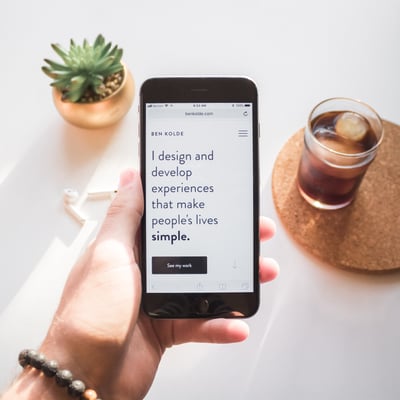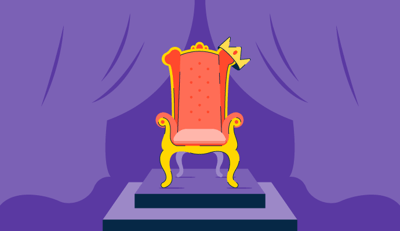April 22, 2021
 by Sarah Brooks / April 22, 2021
by Sarah Brooks / April 22, 2021

When you’re clear on your purpose, your work gets clearer, too.
The passion that comes with knowing how you add value and excelling at your craft allows you to become laser-focused on what lights you up, and nothing else. However, you might not be using personal marketing to your advantage, therefore missing out on potential business or connections.
You’re probably good at many things, right? What if you narrowed that down to just one, the thing you are so passionate about? A personal brand statement can help clarify who you are, what you do, and how you do it. And it has endless benefits.
But most of all, it can transform how you show up professionally.
It’s no secret that when you find purpose in your work, it becomes more meaningful to you. No matter what you do, what your job title is, or what salary you have, when purpose becomes the motivating force in your work, you’ll always feel successful. Purpose can help you feel more connected to a company’s mission, give you the tools to start your own venture, or empower you to change careers.
Cross-culturally, “purpose” has many definitions, and it’s assigned varying levels of importance based on the society you’re a part of. In Japan, however, purpose flows into everything one does, and it’s known as ikigai.
When translated into English, ikigai means “alive” and “worth.” The term originated from Japanese medicine, where integrative wisdom is a major focus. Ikigai can mean purpose in the professional sense, sure, but it also speaks to one’s purpose as a friend, family member, side-hustler, and all the ways one lives fully and deliberately. When you write a personal brand statement, you’re tapping into your purpose and sharing with the world how your gifts can make a difference.
Over the past decade, personal branding has become an ever-increasing focus area for marketers, freelancers, and employee advocates. Celebrities and CEOs have used personal branding to their advantage, catapulting their companies to new heights and gaining an exponential number of opportunities. According to Forbes, did you know when CEOs use social media, 77 percent of buyers are more likely to purchase from that brand?
In a time where first impressions happen digitally, consumers decide if they want to buy a product, work with someone, or engage with a service faster than ever. It takes .05 seconds to form an opinion about a website. G2 found that leads developed through employees’ social media activities convert seven times more frequently than other leads. Your online presence and the content you share impacts the success of your business. So yeah, personal branding? It’s pretty important.
You might be wondering, what is a personal brand statement, and do I really need one to nurture a personal brand? The answer is yes. A personal brand statement is a succinct, one-to-two sentence declaration that shares what you do and how you do it. It helps you clarify your professional vision, attract the right clients or customers, and become a thought leader in your industry.
A personal brand statement matters. It weaves a common thread through the aspects of your work – from your website to your social media accounts to your resume – and tells the world what you’re all about in a concise way. In today’s attention economy, we’re all multitasking, moving faster than ever, and making decisions more quickly. A personal brand statement helps you close the deal, sometimes even before you’ve had to promote yourself.
This article will be your go-to guide for creating your own personal brand statement. You’ll learn how to write it, what needs to be included, where it should live, and examples of high-performing brand statements across industries.
Each of us is unique, which means that each of our professional paths is wildly different from the next. Knowing this, there’s no one-size-fits-all approach to your personal brand statement. However, there are many tried-and-true formulas that can help you create a personal brand statement that delivers.
To start, determining your focus can help you clarify the goals for your personal brand statement. Are you self-employed? Are you doing creative work on the side? Or, are you an employee who wants to be an advocate for the company you work for?
Knowing who you are and how a personal brand statement can benefit you in the first place can help you create a personal brand statement that positions you as a true subject matter expert in your industry.
The first step in writing your personal brand statement is determining your “why.” What has become your purpose in your professional life? If you’re not sure, start by thinking about what lights you up or what encompasses your zone of genius.
Your zone of genius is a term coined by author Gay Hendricks, and it means a place where you’re constantly in the flow of what you’re doing, where you feel creative and inspired, and where you do what you are naturally talented at. Which of your professional outputs fits into this category?
Next, tie your why back to your purpose. How can you use your why to reach customers, close sales, inspire people? What is the motivating force behind what you do? All this will become the backbone of your personal brand statement.
It can also help to consider what sets you apart from others in your field. How do you bring a unique approach to your work or processes? And when you follow that line, how does your unique approach impact consumers in a different way or solve a problem? Think about authenticity first and foremost. There is something about your work and results that only you possess, and you can leverage this in your personal brand statement.
Now that you’ve clarified what you do, next it’s time to consider who you do it for. Trying to be everything to everyone never works. It’s in finding your niche where you’ll find customers, advocates, and supporters who will seek out your services and refer you to their network. Therefore, you have to determine your target audience and stop trying to reach everyone.
For example, are you a freelancer who designs websites for health and wellness companies? Are you a sales leader who thrives in the closed-won stage for tech startups? Or are you an employee who wants to introduce your company’s mission to a certain industry? Write down your target audience, and also brainstorm how your specific abilities can help them get what they need. What do customers seek that you can provide?
Where you are now may not be where you want to end up. And maybe that’s why you’ve put off writing a personal brand statement. First, affirm what you’re doing now and know paths aren’t linear. Next, connect with where you want to be. What steps do you need to take to land this job title or progress a certain way in your career? Do you need additional training or a specific skill that you don’t currently possess? Will you need to earn a certificate or an additional degree?
If you don’t need any outside training, think on which factors or personality characteristics are necessary to make this career step your reality. If you’re not sure, browse job boards. Look at a few postings simultaneously. What factors do they have in common? Jot these qualities down.
You may not know where you want to be, but you have a sense of what you like doing in work. Consider what you’d like your work life to look like in the future as a next step. Do you want to be doing more of this or that in your job? Do you like the hours you’re currently working? Do you want to manage direct reports? Considering this will help you identify leadership qualities that you either already possess or can aspire to.
All this research you’re doing will soon be simplified into one concise, clear statement. Now that you’re thinking about the career you want or goal you have, research individuals who are already there. What do they all have in common, whether it be their professional paths or qualities?
Next, put pen to paper and focus on your personal brand. Write down all the adjectives, verbs, and statements that embody your brand, career path, or goals, plus the personality attributes that make you successful in your work. Reflect on all the brainstorming you’ve already done outside of your personal brand while coming up with this information, too.
Next, it’s time to start playing around with personal brand statement formulas. A popular statement is linking “I” with “what you do” with “how do you do it.” Don’t worry about getting it just right yet, just write out different sections of the formula.
It’s time to bring it all together and formulate your personal brand statement. Take stock of all the research you’ve done; the adjectives, verbs, and statements you’ve written about your personal brand; and the component exercise, and connect with your “why.”
Using all of these pieces, determine a one-sentence representation of the work you do and how you do it. As with puzzle pieces, interchange words and phrases until your personal brand statement reflects the true essence of your personal brand. This means tweaking your personal brand statement for length, tone, and value propositions until it connects back to the holistic research and exercises you’ve done.
It can be tempting to speak to your achievements, and you should absolutely do this if it makes sense. Just make sure you stay clear, cut the fluff, and don’t exaggerate to bolster your personal brand statement. If your personal brand statement sounds inauthentic, it will drive away any potential business or advocates.
Once you’ve refined your personal brand statement, it’s time to start placing it. Sharing your personal brand statement first with friends, coworkers, or social media connections can help you pressure test it, too.
Just how content is tweaked, refreshed, and revised for SEO keywords, outdated information, and style, your personal brand statement needs to evolve with you. You should be checking in on your personal brand statement often, making sure it reflects your professional goals and is in-step with your path.
If you’re taking a career pivot, offering something new in your business that’s now a key focus, or solving a novel problem for your customers, you’re going to want to update your personal brand statement to reflect this. A good rule of thumb is to check your personal brand statement every three months, making sure it aligns with who you are and where you’re going.
When you’ve finalized your personal brand statement, you need to ensure it lives in several places and plays a role in your personal marketing strategy. Think of it this way: A personal brand statement weaves a cohesive thread through all areas where your name is featured. You want your audience to see and share your brand statement, so it’s best to place this in as many places as you can organically do so.
Your personal brand statement should first and foremost be added to your website. Typically this could be featured on your home page or in the About page or section. Next, add your personal brand statement into your social media profiles and add clickable social media buttons to your branded email signature. A LinkedIn headline and Instagram bio are prime real estate for sharing what you do and how you leverage your unique skills. Boost up your resume by placing your personal brand statement beneath your header, sharing with any potential employers what you’re all about right away.
Cross-promotion is a ripe opportunity for sharing your personal brand statement. If you’re writing a guest post or newsletter, or you’re featured as a panelist or webinar host, your personal brand statement can introduce you to an entirely new audience, and ultimately help you reach new customers.
When you use your personal brand statement to connect with others, over time, you can start to be recognized as a thought leader in your field, garnering referrals, networking opportunities, and more.
While there isn’t one tried-and-true approach to writing a personal brand statement, this means you can write yours in a way that feels authentic to you. We’ve rounded up several examples of branding experts who are using the art of personal branding to achieve their goals.
Named a “Personal Branding Expert” by Forbes, Jessica Zweig is the Founder and CEO of SimplyBe., a robust personal branding firm. She also published a book in 2021 all about personal branding. Right on the homepage of her website, Jessica gives us a powerful personal brand statement:
“I work with entrepreneurs, creatives, CEOs and the companies they lead to help them grow on and offline by leveraging the most powerful marketing tool on the planet: authenticity.”
Jessica uses the formula of what she does, why she does it, and how she does it to give her audience a clear sense of her mission.
Taylor Elyse Morrison is the founder of self care startup Inner Workout, which “supports your journey to know, care for, and become your full self.” With events, resources, and education, Inner Workout aims to help people take care on all levels. On the home page of Taylor’s website is her personal brand statement:
“As the founder of Inner Workout and the host of the Be School Podcast, I help people like you connect to and care for their whole selves so that they can create their desired impact.”
Within her personal brand statement, Taylor narrows in on her target audience, uses an inspired, empathic tone, and shares how she helps people achieve their goals.
For coaches and freelancers, a personal brand statement can help your target audience cut through the noise and identify how you can help with a quick scan of the page. Martin McGovern is the Founder and Lead Career Coach for Career Therapy, a professional coaching company working with individuals, small groups, corporations, and education institutions. Martin leverages LinkedIn for his personal marketing strategy, and places his personal brand statement in the headline spot:
“Career Coach helping job seekers navigate the emotional and promotional sides of the job search and change careers with confidence at careertherapy.com.”
Martin’s personal brand statement speaks to common pain points of his audience, like emotional and promotional hurdles in the job search, as well as the stress of changing careers. He also directs new customers to his website for more information. In an attention economy, this seemingly small addition can have a big return for your business.
No matter the formula, cadence, or focus you use for your personal brand statement, there are four elements you should incorporate. These elements will help you narrow in on your purpose and the vision you’ve clarified. Each piece is vital to ensuring you’re selling what you can do, who you can help, and how.
What do you excel at? Think back to your zone of genius. What sets you apart from others in your field or competitors? You should leverage your specialization in your personal brand statement to offer a clear value proposition.
Consider your area of expertise: How can your training, skills, and achievements benefit your customers? Think of common pain points or challenges your target audience faces and how you can help solve them.
Who are you trying to reach with your personal brand statement? Don’t try to appeal to everyone; instead, narrow in on the customers your services could help. What industries are they in? Do they work in specific locations or for specific companies you want to work with? Maintain this focus while crafting your personal brand statement.
Your professional background is unique, and it’s key to use your experiences as a way to build trust and rapport with your target audience. For example, did you train with an industry leader? Exceed your sales goal 10 years in a row? Earn a graduate degree in the field? Each unique aspect of your story will help you shine.
The personal branding industry has grown exponentially over the past decade, and trends indicate it will continue to do so as people recognize the inherent power in defining their professional identities. There are many different paths to creating the perfect personal brand statement, but ensuring it’s authentically you is the key indicator for success.
Sarah Brooks is a freelance copywriter, content marketer, and strategist. She writes inspired brand stories grounded in user insights for world-class brands, from top corporations to growing startups, across digital, email, print, video, and podcasts.
As a designer, you spend most of your time worrying about other people’s brands.
 by Dawson Whitfield
by Dawson Whitfield
It’s always a great time to work on yourself.
 by Mara Calvello
by Mara Calvello
You may think that diversity, equity, and inclusion are just trendy buzzwords. But for...
 by Derek Doeing
by Derek Doeing
As a designer, you spend most of your time worrying about other people’s brands.
 by Dawson Whitfield
by Dawson Whitfield
It’s always a great time to work on yourself.
 by Mara Calvello
by Mara Calvello


